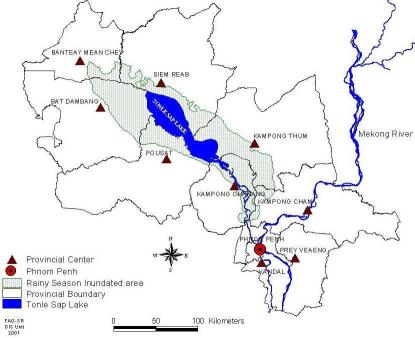The Tonle Sap Lake
The Tonle Sap Great Lake consists of the lake and a flood plain of interconnected streams, ponds,
flooded forests and wetland vegetation that supports a rich biodiversity of species including;
aquatic plants, fish, birds, mammals, reptiles, amphibians, insects and microorganisms. The extensive
biodiversity is linked to seasonal flooding, which sees the Great Lake increase 4 times in area,
from 2500 km2 in the dry season to approximately 10000 km2 in the wet season. There is a strong
relationship between the people and the natural resources of the Great Lake. It supplies the basis
of life to the local people and is one of the largest freshwater fisheries in Asia. The sustainable
management of this highly productive ecosystem is necessary to ensure food security and biodiversity
conservation for Cambodia.


The conservation value of the Great Lake was recognised in 1997 when the United National Education,
Science and Cultural Organisation (UNESCO) and the Royal Government of Cambodia nominated the
Tonle Sap as a Biosphere Reserve. The Biosphere Reserve aims to fulfil three complementary functions:
- Conservation of landscapes, ecosystems, and species diversity
- Culturally, socially and ecologically sustainable development
- Research, monitoring and education
